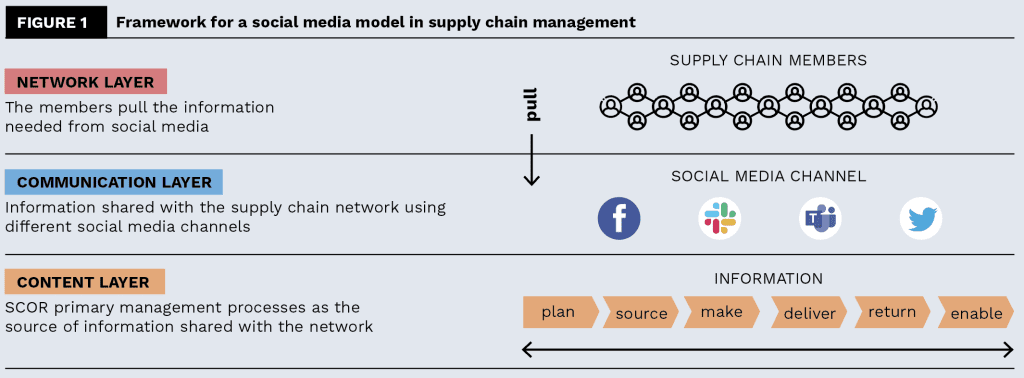In the post-COVID-19 world, a digital form of communication is expected to be more common in the B2B world. A situation where there are fewer physical supplier visits requires new ways of communication, including updates on events in the supply chain. Social media may have the capability to support the required faster communication across the full B2B supply chain.
Digitalisation is the twenty-first-century challenge impacting almost every process in manufacturing industry. The COVID-19 crisis increased the speed at which companies use technology in their day-to-day procedures and demonstrated the advantage of technology to improve supply chain resilience [1]. Access to complete information about process-related supply chain activities appeared to be a critical element in reducing supply chain risks during the crisis [2]. In such times of crisis, appropriate communication within the supply chain becomes even more essential to transfer information among supply chain members, making communication a critical factor towards the actual performance of the supply chain [3]. Most communication occurs between individuals in the supply chain and is typically based on their actual need for information [6]. In addition, during the crisis, customers started to appreciate the reduced number of physical supplier visits and became more open to new ways of communication [7].
Background
The digital transformation has impacted all areas of business interactions, although it seems that the use of social media in supply chain management is relatively unusual for B2B companies. These companies have yet to exploit their potential to improve supply chain effectiveness and increase the experience their supply chain members have of using social media as a communication tool [15-17]. The application of social media itself is not an innovation for B2B companies, as other operational functions, such as human resource management and marketing, are already benefiting from it [11].
So there is nothing new in recommending that B2B companies familiarise themselves with the advantages of social media in supply chain management and build models for a suitable digital engagement with their customers. The barrier or hurdle seems to be that B2B organisations typically perceive social media as a tool for B2C companies promoting their products or for engagement with individuals. There is an assumption that the overall effectiveness of social media and its relevance for the customer relationship is lower in B2B compared to B2C [5].
Although some companies have started using social media in their supply chain management, the opportunities that social media represent seem not to be fully developed. This may reduce the acceptance of social media by B2B companies even further. There are a wide range of advantages to using social media in supply chain management, such as multichannel customer communication, enabling companies to apply the data obtained towards achieving their performance targets. But there are more advantages, such as creating knowledge networks, balancing speed and contemplation, providing portable information vaults, replacing collaboration with community, or building a platform for innovation [10, 11].
Customer experience is also improved through making supply chains more open and transparent to all their members [12]. As an example, Twitter could be used as a communication channel to share messages such as the arrival or departure of a shipment. For instance, a project of the University of Waterloo combines radio frequency identification (RFID) technology with Twitter messages to present updates of movements of goods. The implementation of industrial internet of things (IIoT) technology in B2B environments, such as RFID, might soon accelerate the use of social media in supply chain management [8].
Discussion
For our research, we used a modified stepwise process based on the structured literature review framework of Tranfield, Denyer and Smart to explore the literature [18]. Only publications between 2018 and 2021 were taken into consideration, due to the fast progress of digitalisation. Our research considered models, frameworks or concepts accompanying the application of social media in supply chain management. It shows that an increased number of publications exist starting in 2020, and most of the publications focus on the conditions of social media in supply chain management.
We have not found a framework that streamlines the application of social media in supply chain management to support companies in realising the benefits of faster, customer-oriented communication. To close this gap for practitioners, we reviewed the SCOR (Supply Chain Operations Reference) model, which is often recommended for supply chain performance management [20]. Version 12 of the SCOR model defines five supply chain members: suppliers’ supplier, supplier, producing organisation, customer and customers’ customer. The strength of this model is its consideration of multiple members and its structured activity base, making it independent from any specific B2B industry. Moreover, the SCOR model does not pretend to describe every business activity. It does not cover elements such as demand generation, product development, or research and development. Instead, it provides high-level activities based on six primary supply-chain-related management processes: plan, source, make, deliver, return, and enable. Because of its general structure, this model can be used for global and site-specific projects, as well as for simple and complex supply chains. It considers both upstream and downstream processes [21].

Leveraging social media for B2B supply chain management
When members of a supply chain are given the chance to communicate and share information faster through fewer human interactions, they are likely to be drawn to that way of working. Instead of calling through the supply chain to find information and circle back to the member requiring the information, the actual updates of supply chain activities can be shared using social media channels [2, 5-6].
The availability of instant, reliable information when needed may increase satisfaction and, hence, loyalty between the different supply chain members [16]. Social media transporting information from one supply chain member to the other has the potential to affect loyalty and trust within the supply chain, by making information available fast, at any time, and in a people-oriented way.
Inspired by a framework supporting the communication of engineering design using social media, our framework is designed similarly, using three layers [25]. In the top layer, the network consists of all the members of the supply chain, ranging from the suppliers’ supplier to the customers’ customer, as per the SCOR model [21]. This view allows us to include a wide range of supply chain members, with their different information needs and their complex relationships. Considering the supply chain members as a network gives the opportunity to identify possible groups requiring similar information within the network. Instead of pushing information to all the supply chain members and just assuming that it is relevant, the framework recommends that supply chain members pull the information from social media when, and if, needed. This comes with the advantage that supply chain members do not receive unfiltered information in the form of mass-media, monologue-based communication.
The communication layer in the middle represents the different available social media channels that the members of the supply chain can select from. This communication layer represents the connection between the information and the network, allowing regulation of the information flow [26]. In this middle layer, the supply chain member who maintains the social media channel receives critical responsibilities, such as ensuring that posts are relevant and on time. Private groups might be used to make specific, context-related information available [12]. Regardless of which social media channel is used, the supply chain member maintaining the channel is the actual provider of the information. This information provider needs to ensure that the other supply chain members have access to, and knowledge about, the social media channel used for relevant communication purposes. The supply chain network may have access to different social media channels from different supply chain members. This could lead to a dynamic interweaving of social media within the supply chain network and increase the available information within the supply chain network about actual events. In addition to the responsibility exercised by the information provider, the information enquirer has the responsibility of pulling information from the social media channel in order to stay up to date.
In the lowest layer, the six primary management processes from the SCOR model are used to identify the occurrences in the supply chain to be shared through social media [21]. This presents the opportunity to reach all the supply chain members with the different information needed. The performance of a supply chain is typically affected through multiple supply chain members who require continuous information updates from each other. Considering the source of the information, such as “plan” or “deliver”, supports creating a supply chain network that pulls information from the social media channels, which has an influence on the performance of the supply chain. Each source provides different information and has a different relevance, depending on the actual events. The efficiency of the supply chain depends on the six primary supply-chain-related management processes, which highlights the need for information about a process (for instance “plan”) to be made available to the supply chain members who are active in one of the subsequent processes (for instance, “deliver”) related to the actual events [21].
Each company in the supply chain may decide, based on its own strategy, which detailed content is shared with the network comprised of the supply chain members, such as the customers or the customers’ customer and the direct suppliers. Taking into consideration that some information is confidential or bears certain risks, an organisational strategy and coordinated guidelines for social media usage in supply chain management are needed. This may include which social media channel is suitable for certain information and which information should be shared.
Conclusion
The COVID-19 pandemic has heavily impacted routines in most business processes, including remote working, less personal engagement, and the use of new communication technologies. Finding information online and sharing it through social media channels is part of most people’s daily practices but has not been adopted heavily in the daily activities of B2B supply chain management. The use of social media in supply chain management presents the opportunity to reduce frustration for supply chain members, with more information available at any time, to provide more knowledge about the actual events in the supply chain, and to reduce escalation meetings. Connected operational information in supply chain management is a useful resource . For instance, a manufacturing company can inform its supply chain members via Twitter that a new production batch is starting on a certain day, or provide a status update on a sea cargo. To that end, the proposed framework for social media in supply chain communication specifically allows supply chain practitioners to approach the use of social media in supply chain management in a structured way, and provides support in how to include social media in their day-to-day work.
 Dr Christian Klein is an entrepreneur in digitalisation in manufacturing industry. In his career, he established traditional and digital business units for leading manufacturing companies. With over 15 years’ experience in commercial and project management jobs, he has a unique understanding of digital challenges in manufacturing industry.
Dr Christian Klein is an entrepreneur in digitalisation in manufacturing industry. In his career, he established traditional and digital business units for leading manufacturing companies. With over 15 years’ experience in commercial and project management jobs, he has a unique understanding of digital challenges in manufacturing industry.
References
[1] Ossiannilsson, E. (2020) ‘Reflection on 21st-Century Competences, Smart Learning Environments, and Digitalization in Education’, Near East University Online Journal of Education, 3(2), pp. 87–93.
[2] Remko, van H. (2020) ‘Research opportunities for a more resilient post-COVID-19 supply chain – closing the gap between research findings and industry practice’, International Journal of Operations and Production Management, 40(4), pp. 341–55.
[3] Schoenherr, T., Griffith, D. A. and Chandra, A. (2014) ‘Knowledge management in supply chains: The role of explicit and tacit knowledge’, Journal of Business Logistics, 35(2), pp. 121–35.
[4] Zhang, J. and Du, M. (2020) ‘Utilization and effectiveness of social media message strategy: how B2B brands differ from B2C brands’, Journal of Business and Industrial Marketing. Emerald Group Holdings Ltd., 35(4), pp. 721–40.
[5] Iankova, S., Davies, I., Archer-Brown, C., Marder, B. and Yau, A. (2019) ‘A comparison of social media marketing between B2B, B2C and mixed business models’, Industrial Marketing Management. Elsevier, 81, pp. 169–79.
[6] Koch, S. (2012) ‘Supply Chain Management’, in Koch, S. (ed.) Logistik. 1st edn. Berlin, Heidelberg: Springer Berlin Heidelberg, pp. 245–89.
[7] Sarkis, J. (2021) ‘Supply chain sustainability: learning from the COVID-19 pandemic’, International Journal of Operations and Production Management, 41(1), pp. 63–73.
[8] O’Leary, D. E. (2012) ‘The Use of Social Media in the Supply Chain: Survey and Extensions’, SSRN Electronic Journal, 144, pp. 121–44.
[9] O’Dell, J. (2010) ‘RFID Tagged Cows Start Tweeting’. Available at: http://mashable.com/2010/04/27/cows-on-twitter/ (Accessed: 2 December 2021).
[10] Markova, S. and Petkovska-Mircevska, T. (2013) ‘Social Media and Supply Chain’, Amfiteatru Economic, 15(33), pp. 89–102. Available at: https://www.econstor.eu/handle/10419/168778 (Accessed: 2 December 2021).
[11] Casemore, S. (2012) ‘Social Media and the Coming Supply-Chain Revolution’, CFO Magazine. Available at: https://www.cfo.com/supply-chain/2012/02/social-media-and-the-coming-supply-chain-revolution/ (Accessed: 2 December 2021).
[12] Chae, B. (Kevin), McHaney, R. and Sheu, C. (2019) ‘Exploring social media use in B2B supply chain operations’, Business Horizons. Elsevier Ltd, 63(1), pp. 73–84.
[13] Orji, I. J., Kusi-Sarpong, S. and Gupta, H. (2020) ‘The critical success factors of using social media for supply chain social sustainability in the freight logistics industry’, International Journal of Production Research. Taylor & Francis, 58(5), pp. 1522–39.
[14] Haddud, A. and Khare, A. (2020) ‘Digitalizing supply chains potential benefits and impact on lean operations’, International Journal of Lean Six Sigma, 11(4), pp. 731–65.
[15] Huang, S., Potter, A. and Eyers, D. (2020) ‘Social media in operations and supply chain management: State-of-the-Art and research directions’, International Journal of Production Research. Taylor & Francis, 58(6), pp. 1893–925.
[16] Adam, M., Ibrahim, M., Ikramuddin and Syahputra, H. (2020) ‘The role of digital marketing platforms on supply chain management for customer satisfaction and loyalty in small and medium enterprises (SMEs) at Indonesia’, International Journal of Supply Chain Management, 9(3), pp. 1210–20. Available at: http://ojs.excelingtech.co.uk/index.php/IJSCM/article/view/5027 (Accessed: 2 December 2021).
[17] McFarland, L. A. and Ployhart, R. E. (2015) ‘Social media: A contextual framework to guide research and practice’, Journal of Applied Psychology, 100(6), pp. 1653–77.
18] Tranfield, D., Denyer, D. and Smart, P. (2003) ‘Towards a Methodology for Developing Evidence-Informed Management Knowledge by Means of Systematic Review’, British Journal of Management, pp. 207–22.
[19] Min, H. (2021) ‘Exploring Omni-Channels for Customer-Centric e-Tailing’, MDPI Logistics, 5(2), p. 31.
[20] Kusrini, E., Caneca, V. I., Helia, V. N. and Miranda, S. (2019) ‘Supply Chain Performance Measurement Using Supply Chain Operation Reference (SCOR) 12.0 Model : A Case Study in A Leather SME in Indonesia’, IOP Conference Series: Materials Science and Engineering, 697(1), pp. 0–10.
[21] APICS (2017) APICS Supply Chain Operations Reference Model Version 12.0, APICS. Chicago.
[22] Kreutzer, R. T. (2021) Praxisorientiertes Online-Marketing. 4th edn. Wiesbaden: Springer Fachmedien Wiesbaden.
[23] Babka, S. (2016) Social Media für Führungskräfte. 1st edn. Wiesbaden: Springer Fachmedien.
[24] von Rüden, S., Toller, P. and Terstiege, M. (2020) ‘Digitales Marketing – Herkunft, Zukunft und Trends’, in Terstiege, M. (ed.) Digitales Marketing – Erfolgsmodelle aus der Praxis. Wiesbaden: Springer Fachmedien Wiesbaden.
[25] Gopsill, J. A., McAlpine, H. C. and Hicks, B. J. (2013) ‘A social media framework to support engineering design communication’, Advanced Engineering Informatics. Elsevier Ltd, 27(4), pp. 580–97.
[26] Singh, A., Shukla, N. and Mishra, N. (2018) ‘Social media data analytics to improve supply chain management in food industries’, Transportation Research Part E: Logistics and Transportation Review. Elsevier Ltd, 114, pp. 398–415.



























